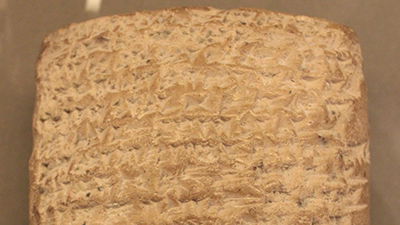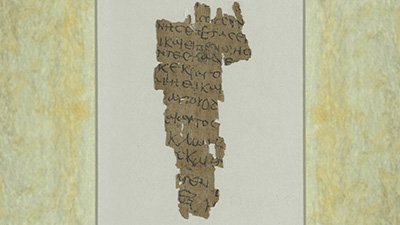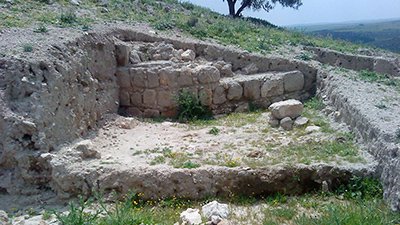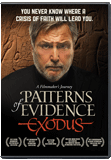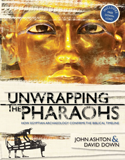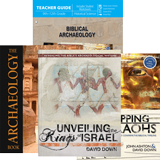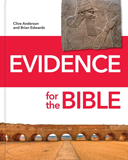Book Review: Patterns of Evidence: The Exodus
Did the Exodus of the Israelites from Egypt under the leadership of Moses leave archaeological footprints we can track today? Many scholars claim it did not. In fact, many scholars also claim that no Hebrew population ever existed in ancient Egypt and that consequently the biblical Exodus never happened because none were there to leave. But if you’ve seen the movie Patterns of Evidence: The Exodus—which was shown in hundreds of theaters across the United States back in January prior to its release on DVD—you know better. You can count yourselves among those in the know! Why? Because you understand that there is plenty of evidence, in addition to the biblical record, supporting the historicity of the Exodus—so long as you look for it in the right timeframe.
Now that your appetite has been whetted by the movie (or by this review), perhaps you’re ready to learn more. Timothy Mahoney, the filmmaker whose quest to learn whether there was credible evidence for the biblical Exodus culminated in the film, has released a more expanded version of his search in book form. Lavishly illustrated with maps, diagrams and photos of archaeological sites as well as lots of “wall of time” timelines to make the information and various points of view clear, this book is a great way to review the facts, to understand both sides of the argument, and to get a firm handle on the answers (1 Peter 3:15; 2 Timothy 2:15) that you need both to understand biblical history in the context of ancient history worldwide and also to defend Scripture.
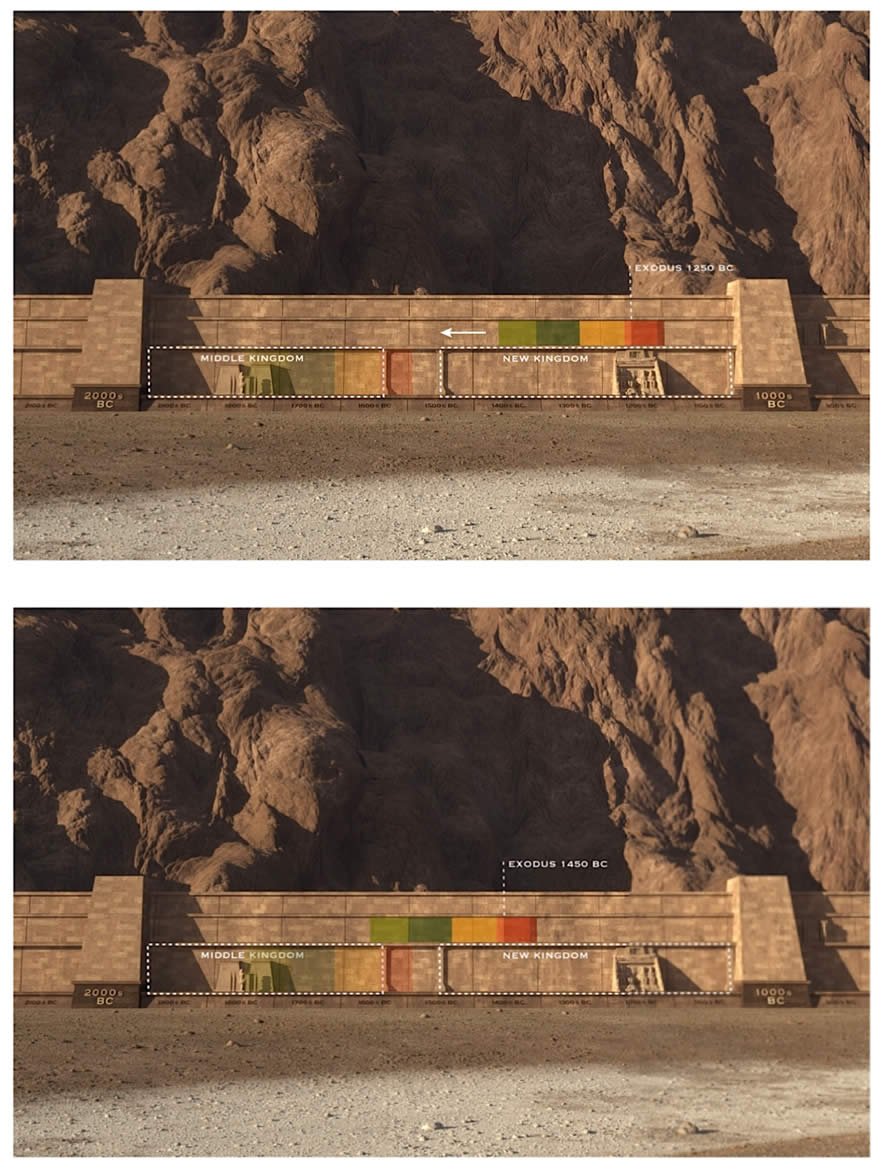
These timelines are just a couple of examples from the book Patterns of Evidence: The Exodus. The upper wall of time shows the traditional view of Egyptian chronology and the “late Exodus” view, which places the Exodus around 1250 BC, during the reign of Ramses the Great. (The reign of Ramses the Great, who built many monuments, is indicated in the 1200s BC by a graphic “monument city” on the wall.) The colored blocks indicate key events such as the arrival of Joseph’s family in Egypt, their multiplication and enslavement—events directly related to the Exodus and the conquest of Canaan. Archaeological evidence for these events is not found when the search is made for it in material related to that timeframe of history, but if the timeframe is shifted backward (white arrow) about two centuries toward Egypt’s Middle Kingdom, and the Exodus is placed around 1450 BC, archaeology tells another story. This is shown in the lower illustration. Image courtesy of Timothy Mahoney, Patterns of Evidence: The Exodus.
Foundation for Faith in Christ Our Cornerstone
As in the movie, Mahoney reveals in the book that his faith was shaken by scholars who claimed that the Exodus as described in the Bible never happened. The opening chapters recount many of the interviews that left him troubled. After all, if the Bible were wrong about this—and if Jesus’ many references to Moses1 were in error—our Christian faith would be on shaky ground.
Jesus Christ, the infallible Son of God, clearly spoke of Moses and other people and events recounted in the Old Testament as historical people and true happenings. If we can’t trust the words of Jesus Christ, then how can we trust Him to save us from sin and be the Lord of our lives? If we can’t trust the opening books of the Bible, then we have a problem when we get to the coming of Christ in the New Testament. If the miracles recorded in the first two books were fairy tales, how would we trust the eyewitness accounts of the death and miraculous Resurrection of Jesus Christ recorded in the New Testament? If the first Passover never happened, wouldn’t it ring hollow to say, “Christ, our Passover, was sacrificed for us
” (1 Corinthians 5:7)?
The Biblical Yardstick
Because we understand that the Bible is God’s Word, and Jesus Himself said that God’s Word is true (John 17:17), we know that the Bible is the yardstick by which archaeological evidence is to be measured, not the other way around. And there are many instances in which skeptics have thought the historical details of Scripture were fabricated but for which later corroborating archaeological finds have been unearthed. And Mahoney notes repeatedly in his book,
Absence of evidence is not evidence of absence.
Scripture—because it does contain divinely inspired, accurate historical information—can even offer clues to guide archaeologists in their searches! As in science, Bible-based predictions can lead to historical, archaeological discoveries. Mahoney explains in his book that 1 Kings 6:1 contains the nugget of information that places the Exodus at the right place on history’s timeline and therefore the spade of the archaeologist at the right place and time to see what Mosaic history has left for us to find.
And it came to pass in the four hundred and eightieth year after the children of Israel had come out of the land of Egypt, in the fourth year of Solomon's reign over Israel, in the month of Ziv, which is the second month, that he began to build the house of the Lord. (1 Kings 6:1)
The Exodus happened 480 years before Solomon began to build the temple. That would mean the Exodus occurred about 200 years before the time currently assigned by most scholars to Rameses the Great, commonly but erroneously viewed by many as the pharaoh of the Exodus. Thus, we see from a historical document divinely inspired by God that those who have claimed that Ramses the Great was the pharaoh of the Exodus have erred by digging for evidence in places dated a couple of centuries too late. They need to dig a little deeper—figuratively and in some cases literally!
Puzzling Out the Pattern
Patterns of Evidence: The Exodus is presented as the story of Mahoney’s search for the truth. In it we see him gradually find the resources and people to piece together evidence for six key Exodus-related events:
- Evidence of Joseph as vizier and the early Israelites’ emigration to Egypt
- Evidence of the prolific multiplication of these Semitic people in Egypt
- Evidence of the enslavement of the Israelites
- Evidence of God’s judgment on Egypt and the resulting Egyptian national disaster
- Evidence of the deliverance and departure of the Semitic population in Egypt
- Evidence in Canaan consistent with their subsequent conquest of the Promised Land
Mahoney recounts his encounters with experts holding many points of view. These include Bryant Wood of the Associates for Biblical Research, the producers of the documentary Jericho Unearthed, which details the sixth piece of this puzzle.
Many key pieces of evidence that helped Mahoney sort out the remaining pieces came to his attention largely through his conversations with an agnostic, David Rohl, who despite his lack of faith in God sees the Old Testament as a valid historical document supportable by archaeological evidence. Rohl’s challenge to traditional Egyptian chronology has brought the problems with traditional dating to the attention of many, both scholars and laypersons. It is refreshing to read how, by viewing the Bible through Rohl’s lens of historical validity, Mahoney came to understand that the Scriptures provide a consistently supportable platform for examining all the archaeological evidence related to the Exodus.
Imagine that! God’s Word had it right all along! And the sands of time have in fact not erased all the archaeological evidence affirming God’s truth.
Archaeological Interpretation
The book Patterns of Evidence: The Exodus is a valuable resource for anyone wishing for a handy, easy-to-understand summary of the issues surrounding the dating of and the evidence for the Exodus. Adult laymen as well as pastors, teachers, and youth group leaders, homeschooling families, and individuals—with or without a burning interest in history!—should find this book interesting reading and a valuable addition to their libraries. After the initial chapters—which are sadly depressing as they are necessarily filled with the words of skeptics—as well as an unbiblical foreword written by Jewish physicist and day-age proponent Gerald Schroeder—the bulk of the book is devoted to presenting the key archaeological discoveries that support each of the six historical steps that must all be satisfied by any collection of evidence pinning the Exodus to a particular place in history.
These discoveries and their significance are each covered along with divergent opinions about their interpretation. One of the books’ strengths is that it does not take a position on which revised Egyptian chronology is right, but rather focuses on the problem with traditional chronology and the fact that any of the proposed chronological revisions point to the patterns of evidence for the Exodus.
Indeed, just as fossils do not come out of the ground wearing little labels with their age and species, so archaeological artifacts must be interpreted. Even after inscriptions are translated, they too must be interpreted. For instance, perhaps an inscription was written by a regime sponsoring a revisionist view of its own history. Ancient kings are not known for carving the records of their defeats on temple walls, after all! Summing up the importance of interpretation in understanding archaeological finds, Mahoney recalls, “Ze'ev Herzog, the Israeli archaeologist, had said, ‘Archaeology is about 10 percent data and 90 percent interpretation.’” [page 4 of chapter 2 in my PDF-preview of the book] Whenever we examine physical evidence from the past—biological or archaeological—and try to determine something about it, we must make certain assumptions that will govern our interpretation.
Assumptions about Egyptian chronology limit the vision of most modern archaeologists as they evaluate discoveries relevant to the six events surrounding the Exodus. Many are convinced that the traditional dates assigned to Egyptian chronology are correct. But as we have discussed in “Doesn’t Egyptian Chronology Prove That the Bible Is Unreliable?,” those incorrect dates ironically began with a misinterpretation of an inscription by early Egyptologists eager to make a connection to a later pharaoh the Old Testament calls Shishak. Now, the chronology built on that very misinterpretation leads many away from trust in the Word of God. An appendix in Mahoney’s book recounts how this problem arose.
The Role of Evidence
Ironically, David Rohl—whose ministrations helped set Timothy Mahoney on the path to finding the evidence he needed to bolster his own faith in God’s Word and to make a film that should show many skeptics that the Bible is trustworthy—does not himself believe in God. Rohl accepts the value of the Bible as a historical record, but he has not accepted the God of the Word as his Savior.
There is in this an important lesson for Christian apologists. Often Christians think that if they can just show people enough evidence that the Bible is true, they will automatically, inevitably believe and be saved. Yet while evidence is an important way not only to remove many stumbling blocks to faith for skeptics but also to strengthen the faith of believers and provide them with the answers their children, family, friends, and co-workers need, evidence alone is not enough to bring people to salvation.
People need not only information but also spiritual transformation. People—all people—are sinners in need of repentance and God’s saving grace through Jesus Christ, “our Passover . . . sacrificed for us” (1 Corinthians 5:7). The Bible commands us to be prepared to give answers (1 Peter 3:15) in the hope that people will ultimately repent and believe the gospel (2 Timothy 2:23–26). Jesus Himself told us about this about 2,000 years ago in the parable of the rich man and Lazarus (Luke 16:19–31).
But he [Jesus] said to him, “If they do not hear Moses and the prophets, neither will they be persuaded though one rise from the dead.” (Luke 16:31)
Jesus, of course, ultimately did rise from the dead. And the Jewish leaders who arranged to have Him crucified knew the truth when the guards from the tomb told them about the empty tomb (Matthew 28:11–15). Instead of repenting for their rejection of God’s Messiah, they propagated a lie. Thankfully we learn later that some of the Jewish priestly leadership eventually did believe (Acts 6:7), though whether any of those who actively covered up the evidence of the Resurrection were among those later believers we do not know. The many infallible proofs (Acts 1:3) of Christ’s Resurrection attest to His divinity and His right to be worshipped. Countless people then and now have received eternal salvation by repenting and trusting in Christ’s sacrifice and victory over death.
Saving faith does come by hearing the Word of God (Romans 10:17)—which is the reason we at Answers in Genesis constantly teach its truths and proclaim its trustworthiness. While not everyone who sees the evidence that the Bible is true comes to God for salvation, for many that is the first step. Therefore, it is our responsibility both to study and share the answers that will remove historical, archaeological, or scientific stumbling blocks to their faith and also to pray for them, that the convicting power of God’s Word will touch their hearts and minds and ultimately bring them to salvation. Thus it is incumbent upon us all to equip ourselves to answer the questions of skeptics, to build up and share our own faith, and to bolster the faith of our fellow believers.
Due to the nature of the foreword included in the first edition of the book Pattern of Evidence: The Exodus, we have opted not to carry the book in our web store. Apart from the foreword, the book is an excellent resource, however, and is available from the publisher, Thinking Man Media.
Further Reading
Footnotes
- In the movie reviewwe posted about the corresponding movie, we pointed out many of the references to Moses made by the infallible Son of God, Jesus Christ, whom the New Testament refers to as “our Passover” (1 Corinthians 5:7). Jesus repeatedly refers to Mosaic history and law. For example, in Matthew 8:4 he commands the leprous man he healed to “
offer the gift that Moses commanded you, as a testimony to them
.” In Matthew 19:7–8 He asks, “Why then did Moses command . . . ?” and answers, “Moses, because of the hardness of your hearts, permitted you . . .
” as He reconciled God’s hatred of divorce (Malachi 2:16–17) with the existence of laws making it possible. To illustrate how the Jewish leaders had twisted God’s Word and made it ineffectual (Mark 7:13), Jesus began with “For Moses said . . .
” (Mark 7:10). Explaining His identity and mission to Nicodemus, Jesus said, “And as Moses lifted up the serpent in the wilderness even so must the Son of Man be lifted up
” (John 3:14). Jesus referred in John 7:19 to the presentation of God’s Ten Commandments through Moses: “Did not Moses give you the law, yet none of you keeps the law?
” Jesus recalled the historical giving of manna in the wilderness: “Then Jesus said to them, ‘Most assuredly, I say to you, Moses did not give you the bread from heaven, but My Father gives you the true bread from heaven
” (John 6:32). Jesus recalled the re-establishment of the rite of circumcision under Moses: “Moses therefore gave you circumcision (not that it is from Moses, but from the fathers)
” (John 7:22). The writer of the Gospel of John explained, “For the law was given through Moses, but grace and truth came through Jesus Christ
” (John 1:17). Jesus told the Pharisees that if they really believed what Moses wrote they would believe in Him: “For if you believed Moses, you would believe Me; for he wrote about Me. But if you do not believe his writings, how will you believe My words
” (John 5:46–47).
Recommended Resources

Answers in Genesis is an apologetics ministry, dedicated to helping Christians defend their faith and proclaim the good news of Jesus Christ.
- Customer Service 800.778.3390
- © 2024 Answers in Genesis


